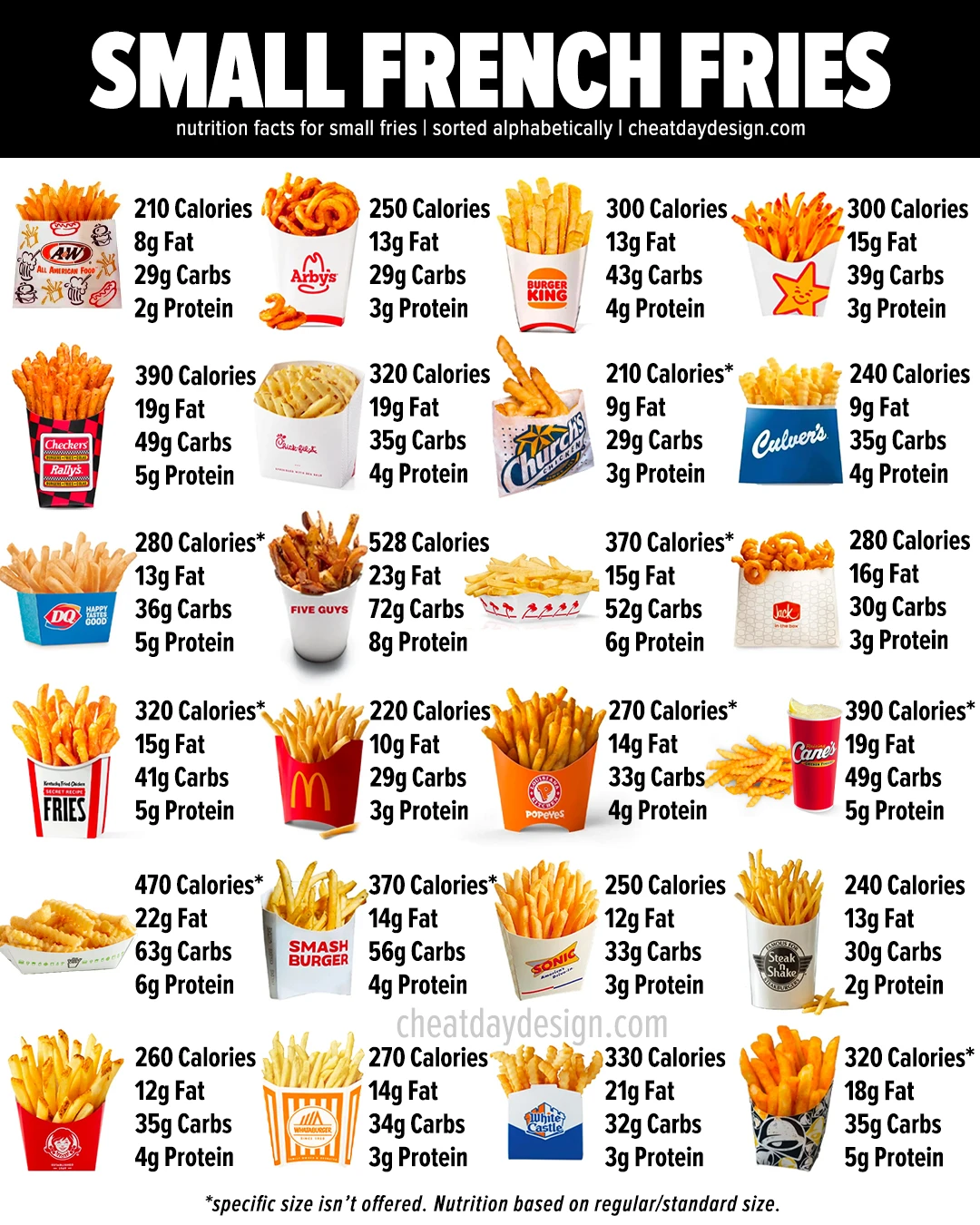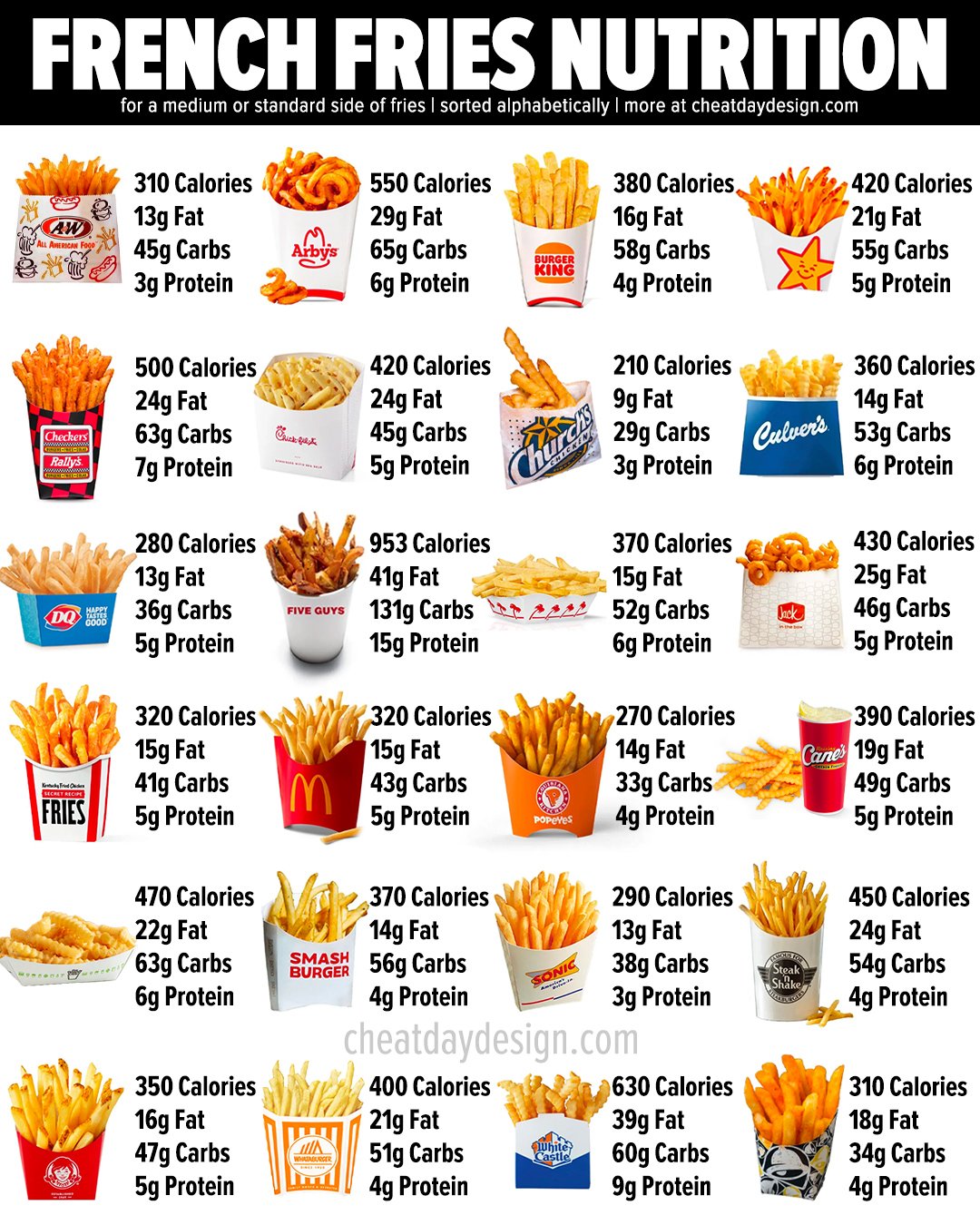There are few things in this world better than hot, crispy French fries.
It’s no secret that french fries aren’t exactly a health food, since we know that most deep fried food is not typically associated with overall healthy diets.
But, in case you’re new around here, I don’t believe in labeling foods as “unhealthy.” If you want to enjoy some fast food fries, I believe you should do exactly that.
Some food may be better than others to eat on a regular basis, but that doesn’t make any one particular food bad. Yes, even French fries.
Whether you’re searching for the fries with the fewest calories, or simply curious how many calories are in fast food French fries, I’ve got you covered.
Can You Eat Fries As Part of a Healthy Diet?

In short: absolutely!
Fries (and fast food in general) are too often associated with unhealthy lifestyles, but that does not need to be the case at all.
As long as you practice moderation, you can absolutely eat a side of fries as part of a healthy diet.
Fries are often considered “empty calories” because they do not offer a ton of nutrition benefits. Since french fries are just deep-fried potatoes, we’re getting mostly carbs & fat with not much else. Order loaded fries, and things get even worse for most people.
On top of that, the oil that french fries are cooked in doesn’t exactly scream healthy (although is not automatically bad, so don’t be immediately scared if you see ).
But, all of that being said, french fries are a treat. As long as they are not a daily staple in your diet, there is nothing wrong with having some fries. Yes, even a large fry!
Sure, you’ll be consuming high amounts of fat & carbs. But remember: it is one meal.
One meal, one day, even an entire week, is never going to de-rail your progress. It’s okay to eat food strictly because you enjoy it.
Calories in Sweet Potato Fries vs Regular Fries

I’ve seen a lot of people looking towards sweet potatoes in an effort to be healthier.
In fact, I was one of those people for a very long time. If I was buying , or ordering at a restaurant, I would opt for only.
The problem is, a large majority of people have no idea what actually makes sweet potatoes healthier, they’ve just heard that they are “better.”
From a calorie and nutrition standpoint, both fries are very similar. Looking at the comparisons above, an equal serving size is going to give you virtually identical nutrition, with the obvious standout being the sugar content (I mean, they are SWEET potatoes after all).
The reason sweet potatoes are generally considered healthier is their micronutrient profiles (AKA vitamins and minerals).
You can see here that these sweet potato fries are loaded with Vitamin A, but a regular sweet potato will actually provide you with Vitamin A, Vitamin C, B6, along with some other vitamins in smaller quantities.
From a weight loss standpoint, sweet potatoes actually don’t hold much of an advantage. In fact, the nutrition facts are extremely similar to regular fries.
If you’re like me, you just love sweet potato fries. If that’s the case, keep enjoying them! But you don’t need to blindly choose them in an effort to be healthier, because there truly is not much of a difference between the two.
Fast Food French Fry Sizes
Depending on which fast food restaurant you visit, the exact size of the fries is going to vary quite a bit.
For example, it’s no secret that Five Guys offers a TON of fries, whereas somewhere like McDonald’s will give you significantly fewer fries.
There is no exact amount of fries you’ll get with each size, but we can give a rough estimate based on the nutritional information we have available. Here’s how many fries you can expect to find in small, medium, and large fries.

A typical serving of fries is 3oz. If you purchase frozen French fries at the grocery store, the nutrition facts will be listed for a 3oz serving.
Most small fries at fast food restaurants contain closer to 4oz of fries, but as I said previously, it varies based on where you go.
So, assuming a small fry is 3-4oz, we can estimate the number of fries in each serving.
McDonald’s has very thin fries, so you’ll receive more fries per serving than somewhere like Chick-fil-A, which offers large waffle fries.
Calories in Fast Food French Fries
If you’re eating french fries, you’re likely not too concerned with trying to eat as few calories as possible. But, like all of my guides that I put together, I find it very helpful to know what I’m consuming.
I’m a big fan of tracking my food intake, and as someone who follows a flexible dieting approach, I like to fit my takeout meals into my daily intake. For me, knowing the calories & nutrition of my food is very helpful!
Since each fast food restaurant has completely different ingredients, let’s compare the calories in french fries for 24 different popular fast food chains.
We’ll get into each individual option below, so you can dive into the specific macros for each one. But if you’re short on time, here are some helpful infographics that you can save for future reference.
First up, we have all the small fast food French fries.

Note that in this graphic, there are a handful of restaurants that don’t offer small fries: Church’s Chicken, DQ, Popeyes, Raising Cane’s, KFC, Smash Burger, and Taco Bell. The nutrition facts listed for those restaurants are either for a standard side of fries or a medium.
This leads us to our next size…

The serving size for a medium or standard side of fries can vary greatly, as seen by the difference between Burger King, with 370 calories, and Five Guys, with over 950 calories.
Clearly the amount of fries you’ll receive will differ, so it’s not exactly an apples-to-apples comparison for all of them.
And finally, we have large fries.

Similar to small fries, there are a handful of establishments that don’t offer large fries: In-N-Out, Raising Cane’s, Popeyes, Shake Shack, and Taco Bell.
Now that we’ve got the stage set, let’s dive into each different fast food restaurant (in alphabetical order).

A&W Fries
Small A&W Fries: 210 Calories, 8g Fat, 29g Carbs, 2g Protein
Regular A&W Fries: 310 Calories, 13g Fat, 45g Carbs, 3g Protein
Large A&W Fries: 430 Calories, 17g Fat, 61g Carbs, 5g Protein
Arby’s Curly Fries
Small Curly Fries: 250 Calories, 13g Fat, 29g Carbs, 3g Protein
Medium Curly Fries: 410 Calories, 22g Fat, 49g Carbs, 5g Protein
Large Curly Fries: 550 Calories, 29g Fat, 65g Carbs, 6g Protein
Burger King Fries
Small Burger King Fries: 300 Calories, 13g Fat, 43g Carbs, 4g Protein
Medium Burger King Fries: 370 Calories, 16g Fat, 54g Carbs, 5g Protein
Large Burger King Fries: 440 Calories, 19g Fat, 64g Carbs, 5g Protein
Carl’s Jr./Hardee’s Natural Cut Fries
Kids’ Natural Cut French Fries: 240 Calories, 12g Fat, 31g Carbs, 3g Protein
Small Natural Cut French Fries: 300 Calories, 15g Fat, 39g Carbs, 3g Protein
Medium Natural Cut French Fries: 420 Calories, 21g Fat, 55g Carbs, 5g Protein
Large Natural Cut French Fries: 460 Calories, 22g Fat, 59g Carbs, 5g Protein
Checkers / Rally’s Fries
Small Checkers Fries: 390 Calories, 19g Fat, 49g Carbs, 5g Protein
Medium Checkers Fries: 500 Calories, 24g Fat, 63g Carbs, 7g Protein
Large Checkers Fries: 590 Calories, 29g Fat, 74g Carbs, 8g Protein
Fry Lover’s XL Checkers Fries: 910 Calories, 45g Fat, 115g Carbs, 12g Protein
Chick-fil-A Waffle Fries
Small Chick-fil-A Fries: 320 Calories, 19g Fat, 35g Carbs, 4g Protein
Medium Chick-fil-A Fries: 420 Calories, 24g Fat, 45g Carbs, 5g Protein
Large Chick-fil-A Fries: 600 Calories, 35g Fat, 65g Carbs, 7g Protein
Church’s Chicken Fries
Regular Fries: 210 Calories, 9g Fat, 29g Carbs, 3g Protein
Large Fries: 570 Calories, 24g Fat, 80g Carbs, 7g Protein
Culver’s Crinkle Cut Fries
Small Crinkle Cut Fries: 240 Calories, 9g Fat, 35g Carbs, 4g Protein
Medium Crinkle Cut Fries: 360 Calories, 14g Fat, 53g Carbs, 6g Protein
Large Crinkle Cut Fries: 460 Calories, 18g Fat, 68g Carbs, 7g Protein

Dairy Queen Fries
Dairy Queen Kids’ Fries: 170 Calories, 8g Fat, 23g Carbs, 3g Protein
Dairy Queen Regular Fries: 280 Calories, 13g Fat, 36g Carbs, 5g Protein
Dairy Queen Large Fries: 450 Calories, 21g Fat, 59g Carbs, 8g Protein
Five Guys Fries
Little Side of Fries: 528 Calories, 23g Fat, 72g Carbs, 8g Protein
Regular Side of Fries: 953 Calories, 41g Fat, 131g Carbs, 15g Protein
Large Side of Fries: 1,314 Calories, 57g Fat, 181g Carbs, 20g Protein
*Five Guys is a bit of an outlier here because their servings are HUGE, but the sizes still apply.
In-N-Out Fries
Side of Fries (One Size): 370 Calories, 15g Fat, 52g Carbs, 6g Protein
Jack In The Box Fries
Small Jack In The Box Curly Fries: 280 Calories, 16g Fat, 30g Carbs, 3g Protein
Medium Jack In The Box Curly Fries: 430 Calories, 25g Fat, 46g Carbs, 5g Protein
Large Jack In The Box Curly Fries: 580 Calories, 34g Fat, 63g Carbs, 7g Protein
Small Jack In The Box French Fries: 330 Calories, 15g Fat, 45g Carbs, 4g Protein
Medium Jack In The Box French Fries: 450 Calories, 21g Fat, 61g Carbs, 5g Protein
Large Jack In The Box French Fries: 610 Calories, 28g Fat, 83g Carbs, 7g Protein
KFC Secret Recipe Fries
Regular KFC Fries: 320 Calories, 15g Fat, 41g Carbs, 5g Protein
Large (Family) KFC Fries: 840 Calories, 40g Fat, 108g Carbs, 13g Protein

McDonald’s Fries
McDonald’s Kids’ Fries: 110 Calories, 5g Fat, 15g Carbs, 2g Protein
McDonald’s Small Fries: 220 Calories, 10g Fat, 29g Carbs, 3g Protein
McDonald’s Medium Fries: 320 Calories, 15g Fat, 43g Carbs, 5g Protein
McDonald’s Large Fries: 490 Calories, 23g Fat, 66g Carbs, 7g Protein
Popeyes Cajun Fries
Regular Popeyes Cajun Fries: 270 Calories, 14g Fat, 33g Carbs, 4g Protein

Raising Cane’s Crinkle Cut Fries
Side of Fries (One Size): 390 Calories, 19g Fat, 49g Carbs, 5g Protein
Shake Shack Fries
Side of Fries (One Size): 470 Calories, 22g Fat, 63g Carbs, 6g Protein
Smashburger Fries
Smashburger has the widest selection of fries- most fast food restaurants will have a single option, but Smashburger has 4 different types of fries to choose from (as well as tater tots, which didn’t quite make the cut for this list).
Regular French Fries: 370 Calories, 14g Fat, 56g Carbs, 4g Protein
Large French Fries: 560 Calories, 21g Fat, 84g Carbs, 6g Protein
Regular Smash Fries: 420 Calories, 21g Fat, 53g Carbs, 4g Protein
Large Smash Fries: 630 Calories, 32g Fat, 80g Carbs, 6g Protein
Regular Sweet Potato Fries: 440 Calories, 20g Fat, 61g Carbs, 4g Protein
Large Sweet Potato Fries: 720 Calories, 33g Fat, 99g Carbs, 7g Protein
Regular Sweet Potato Smash Fries: 550 Calories, 33g Fat, 61g Carbs, 4g Protein
Large Sweet Potato Smash Fries: 830 Calories, 50g Fat, 92g Carbs, 6g Protein

Sonic Fries
Small Sonic Fries: 250 Calories, 12g Fat, 33g Carbs, 3g Protein
Medium Sonic Fries: 290 Calories, 13g Fat, 38g Carbs, 3g Protein
Large Sonic Fries: 470 Calories, 22g Fat, 63g Carbs, 5g Protein
Steak ‘n Shake Fries
Kids Thin N’ Crispy Fries: 150 Calories, 8g Fat, 19g Carbs, 1g Protein
Small Thin N’ Crispy Fries: 240 Calories, 13g Fat, 30g Carbs, 2g Protein
Medium Thin N’ Crispy Fries: 450 Calories, 24g Fat, 54g Carbs, 4g Protein
Large Thin N’ Crispy Fries: 650 Calories, 34g Fat, 79g Carbs, 6g Protein
Small Seasoned Fries: 250 Calories, 13g Fat, 30g Carbs, 2g Protein
Medium Seasoned Fries: 450 Calories, 24g Fat, 55g Carbs, 4g Protein
Large Seasoned Fries: 660 Calories, 35g Fat, 80g Carbs, 6g Protein
Wendy’s Fries
Wendy’s Junior Fries: 210 Calories, 9g Fat, 28g Carbs, 3g Protein
Wendy’s Small Fries: 260 Calories, 12g Fat, 35g Carbs, 4g Protein
Wendy’s Medium Fries: 350 Calories, 16g Fat, 47g Carbs, 5g Protein
Wendy’s Large Fries: 470 Calories, 21g Fat, 63g Carbs, 7g Protein
Whataburger French Fries
Small Whataburger Fries: 270 Calories, 14g Fat, 34g Carbs, 3g Protein
Medium Whataburger Fries: 400 Calories, 21g Fat, 51g Carbs, 4g Protein
Large Whataburger Fries: 530 Calories, 28g Fat, 68g Carbs, 6g Protein
White Castle French Fries
White Castle fries actually vary slightly based on location, and New York/New Jersey or Scottdales/Orlando actually have their own nutrition facts. Below are the general nutrition facts for every other White Castle location.
Small White Castle Fries: 330 Calories, 21g Fat, 32g Carbs, 3g Protein
Medium White Castle Fries: 600 Calories, 39g Fat, 57g Carbs, 6g Protein
Sack (Serves 3) White Castle Fries: 770 Calories, 49g Fat, 76g Carbs, 8g Protein
Taco Bell Nacho Fries
Taco Bell’s Nacho Fries come and go every year, so get them while you can! They are currently back for 2023, so take advantage and head over to Taco Bell.
Taco Bell Nacho Fries (One Size): 320 Calories, 18g Fat, 35g Carbs, 5g Protein
How Much Sodium Are in Fast Food Fries?
You may have noticed that I left sodium off this guide.
That was on purpose, because seeing high amounts of sodium tends to scare people, and it’s not totally warranted.
Sure, if you have certain health conditions, you’ll want to be careful with your sodium intake. And if you go way overboard, then it may become an issue.
But for healthy, active individuals, sodium is not a bad thing at all! In fact, we need it in our diets.
Here are a few examples of sodium in medium french fries, to give you an idea of what to expect when eating french fries:
- in : 230mg
- in Burger King fries: 570mg
- in Wendy’s fries: 280mg
- in Chick-fil-A fries: 240mg
As you can see, some are higher than others, but you can estimate 250-300mg of sodium for a medium order of french fries.
If you’re watching your sodium intake, you can ask for your fries to be unsalted! All of the sodium in french fries comes from the salt that is added after frying, so if you ask to leave it off, you can control your sodium intake however you’d like.
PS: Similar to , I chose not to include or in this comparison. Since every feels differently about their intake, it felt like it may be too misleading to include them. Check out my breakdown of the different dietary fats if you want to learn more about or .
How Many Calories are in Different Condiments?
When it comes to french fries, you’re rarely eating them plain. Depending on what dipping sauce you choose, it can add a fair amount of additional calories.
Here’s a quick guide to break down the calories in most popular condiments:

These calories are for a standard side of each sauce (those little cups you get if you’re dining at a restaurant).
Certain fast food restaurants, like Chick-fil-A, have all their own dipping sauces, so calories will vary based on where you go.
My condiment tip: Whenever I order fast food, I don’t get any condiments at all. I enjoy ketchup, and I started buying “no sugar added” ketchup from Heinz, so it is always fully stocked in my fridge. WhenI bring my food home, that is what I use! At only 5 calories per serving, it keeps the caloric impact very minimal. If I’m on the go I will use the ketchup that comes with the meal, but I use it very sparingly, or I’ll mix it with hot sauce to add a little bit of volume without many extra calories.
Conclusion: How Healthy Are Fries, Really?
As you can see by this guide, the calories and nutrition facts for fast food fries are all over the place.
Serving sizes vary, fries are cut differently, and the types of cooking oil can vary as well, so all fries are not created equally.
However, my goal with this post, and any posts like this, are to show you that you can certainly enjoy fries as part of a healthy diet.
Sure, deep fried potatoes may not scream “healthy,” and that’s totally fine.
By breaking down the various options into their calories and macros, we can see that it’s all just food. Maybe those macros don’t directly benefit your goals the way a healthier alternative might, but does that make them bad? Absolutely not.
French fries themselves may not be a traditional healthy option, but it’s not a bad option, especially in moderation. You can absolutely enjoy fries as part of any healthy diet!
























